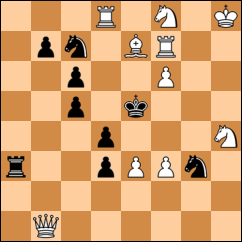#2 (10+9) C+
Jorge M. Kapros
5º Premio MT Horacio Musante -2017
1. Db6? [2. Dxc7#]
1. … Sc7 ~ / Sd5! / Se6! 2. Dxc5 / Ld6! / Sfg6!#
1. … Sf5 / Se4 2. Shg6 / f4#
But 1. … Sa6! 2. ?
1. Dg1! [2. Dxg3#]
1. … Sg3 ~ / Sf5! / Se4! 2. Dg5 / Shg6! / f4!#
1. … Sd5 / Se6 2. Ld6 / Sfg6#
Theme and comment:
Black correction of Sc7 in try 1.Db6? & black correction of Sg3 in solution 1.Dg1!
Defenses Sf5/Se4 & Sd5/Se6 exchange the type of threats -primary or secondary- that they prevent between the two phases.
Primary threat is the threat that is posed by the key.
Secondary threat is a potential mate that emerge when a certain black unit moves at random.
When 1.Db6?
– 1…,Sf5 & 1.., Se4 prevent a primary threat (the primary threat is Dxc7 posed by the key)
– 1…,Sd5 & 1.., Se6 prevent a secondary threat (the secondary threat is Dxc5 that emerges after Sc7 moves at random)
When 1.Dg1!
– 1…,Sf5 & 1.., Se4 prevent a secondary threat (the secondary threat is Dg5 that emerges after Sg3 moves at random)
– 1…,Sd5 & 1.., Se6 prevent a primary threat (the primary threat is Dxg3 posed by the key)

